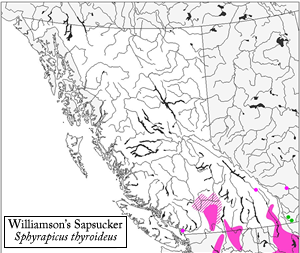Both sexes are very distinctive and should not present any identification concerns. The barred upperparts, white rump, and brown head of female Williamson’s Sapsucker may bring to mind a Northern Flicker, but that species is much larger with black-barred, brownish upperparts (rather than white-barred, blackish upperparts) and bold black spotting on the underparts.
| The primary call of both sexes is a strong, clear queeah or cheeurrr that is less mewing than the similar calls of other sapsucker species. Both sexes also give a variably-paced series of soft chattering notes for communication: ch-ch-ch-ch-ch. The male’s drumming pattern consists of a rapid burst of pulses followed by a slow, irregularly series of single taps with fading vibration; this drumming pattern is similar to other sapsuckers but the initial burst of drumming is faster and there are longer pauses between the single taps at the end. Females occasionally drum, but do so much less often than the males. Source: Dobbs et al. (1997); Sibley (2000) |
Courtship
Males arrive on the breeding grounds 1-2 weeks before females and commence establishing territories. Courtship displays begin immediately upon arrival of females on the breeding grounds. The primary method of courtship by the male is drumming, which is done frequently during pair formation, especially in the morning, and then only infrequently afterwards (primarily in the late afternoon). Various soft calls are also involved in courtship activities and pair formation. The male responds to female solicitation with a variety of precopulatory displays (chatter call, wing fluttering, head bobbing, tail wagging, erecting feathers on the crown and throat). The male sometimes engages in a fluttering aerial display, especially if it approaches a potential mate on the wing. This species is monogamous and the pair remain together throughout the breeding season, occasionally remating in subsequent years.
Nest
The nest is typically constructed within a cavity in a dead or live tree (coniferous or deciduous), but occasional nests have been documented in telephone poles. Both sexes participate in excavating the nest cavity, which commences within 3 weeks of the arrival of the females on the breeding grounds and takes 3-4 weeks to complete; thus, most nests are constructed between mid-April and mid-May. The diameter of the entrance hole is ~3-4 cm and the cavity is usually ~20 cm deep. The height of the nest cavity ranges from 2-18 m, although most nests are between 2-6 m in height. The nest itself is a simple lining of wood chips and shavings at the bottom of the cavity which serve as a bed for the eggs. This species often uses the same tree for nesting during different years, but excavates a new nest hole each year.
Eggs
A single clutch of (3) 4-6 (7) eggs is laid between mid-April and late May and is incubated by both parents for 12-14 days before hatching. Eggs are present in B.C. between mid-April and mid-June. The smooth, slightly glossy eggs are pure white with no markings.
Young
The nestlings are altricial and naked upon hatching, with bright pink skin. Both parents brood the young, which fledge at 26-35 days of age. The young are tended by the female for 1-2 days after fledging, but both parents abandon the young very quickly after they leave the nest. Nestlings are present in B.C. between early May and mid-July, although most occur in June.
Source: Campbell et al. (1990b); Winkler et al. (1995); Baicich and Harrison (1997); Dobbs et al. (1997)
|
Like most woodpeckers, the vast majority of foraging time is spent along the trunk and branches of trees, particularly living or dead conifers (occasionally aspen), although it will sometimes forage on the ground. Some individuals in B.C. have been observed gleaning small insects from the spent flowering spikes of the roadside weed Woolly Mullein (Verbascum thapsus) in late summer. The Williamson’s Sapsucker displays a high degree of seasonal specialization in its diet. During the prenestling period, conifer sap and phloem composes nearly 100% of the diet, but once the eggs have hatched this species switches to a diet consisting primarily of ants, which are also fed to the young. When foraging for sap, this species (like other sapsuckers) drills concentric rings of shallow holes (‘wells’) in the bark to allow the sap to flow out. When foraging for insects, it typically gleans them from the surface of bark or, in some cases, removes sections of bark to access the insects hiding beneath it. It will also consume insects that are attracted to the sap flowing from its sap ‘wells’, and has been known to capture flying insects by ‘hawking’ (flying out from a perch to capture an insect in flight, then returning to the perch). Non-breeding birds sometimes consume fruits and berries, including juniper berries.
Source: Winkler et al. (1995); Dobbs et al. (1997)
|
|

